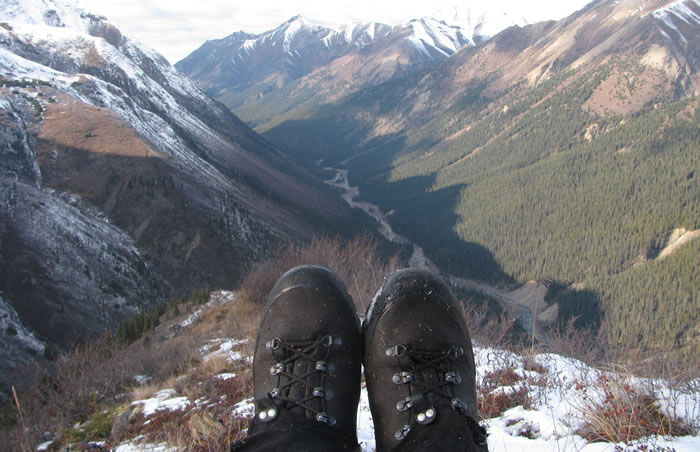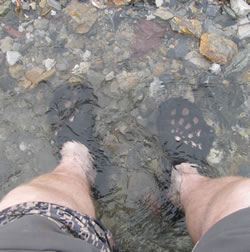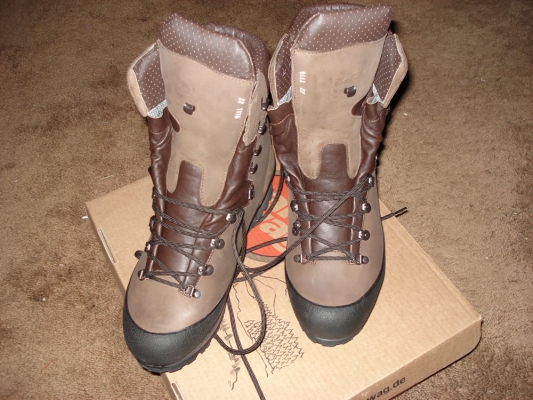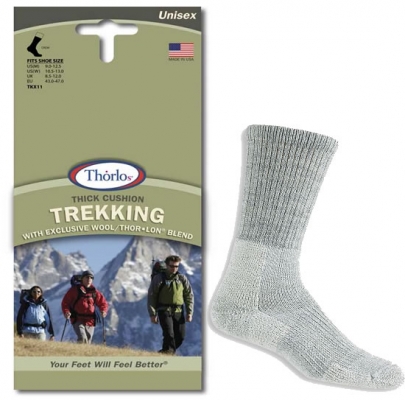
** Updated and Revised – July 2016 **
When all you’ve got to get around in the mountains are two-feet-and-a-heartbeat then you’d better make damn sure your feet are up to the challenge. Wet, tired and sore feet suck and there are many different ways to help your feet better on a long, steep trail with a heavy pack.
Making a point of taking care of your feet on a backpack hunting trip helps you avoid blisters and sore spots and it can keep you hunting longer. On most of the backpack hunts I’ve been on there are plenty of rainy, foggy days to lay around and recuperate so when the hunting is good, your feet need to be good-to-go!
Here’s how I take care of my feet in the mountains.
#1. Boots – Don’t screw around and cheap out on your boots, when you’re hiking around the mountains with a 50+ pound pack you need a boot that provides excellent support. My boot of choice is Hanwag and other popular choices are Lowa, Schnees, Danner, Kennetrek, La Sportiva and others. When sizing your boot make sure you leave enough room for an insole and thick cushioned socks as the stock footbeds in most boots are insufficient for extended periods in rocky/hard mountainous terrain, for my feet anways. I prefer to use the Lathrop & Sons High Country Footbed in my boots, and they add the extra bit of support and cushioning to keep my feet comfortable.
#2. Socks – I’ve spent a few hundred bucks over the years trying different brands of socks, and the best I’ve come across so far is a sock made by Thorlo called the “Trekking” sock. These socks are cushioned to the max, offer moisture wicking properties and most importantly help prevent your feet from hurting. They are not cheap at approx $25.00 per pair but a few times per year Thorlo throws a buy 3 get the 4th free sale and 4-5 pairs would be good enough for a 7-10 day backpack hunt. They say “Level III” cushioning on the side.
#3. Liner Socks – In addition to several pairs of Thorlo socks I also make sure to take along at least 1 pair of merino wool liner socks. The liners go on your feet before the Thorlo sock and act as a friction barrier between your foot and the sock, it’s very helpful in preventing blisters. My last trip I ended up melting my only pair of liner socks trying to dry them by the fire and had to go without for the rest of the trip and they do make a difference, for my feet at least. On my next trip I’ll be taking two pairs.
#4. Hiking Poles – Hiking poles/Trekking poles help take weight off your feet/ankles/knees as it’s transferred into your upper body. These go alooooong way in helping you keep your legs as a whole, in good shape. Your feet will feel better at the end of the day too. Don’t buy cheap poles either… You could get hurt if your poles choose to collapse at the wrong time, crossing creeks, traversing boulder fields, all require you to have sure footing and if you put all your weight on the poles to make a movement and it collapses you could be in a world of hurt. Why am I telling you this? Because the cheap poles have really shitty locking mechanisms and they will come loose frequently on the trail, they could fail when you need to rely on them. I use a set of Leki trekking poles that have held up for a few years now and without any unexpected collapses.

Be careful drying your boots by the fire! You can ruin a pair of hunting boots quickly.
#5. Take Your Boots Off – Seriously, everytime we stop to glass, or take a 10 minute break, I always take my boots off if the situations warrants it, and sometimes I’ll take my socks too if it’s nice out and turn them inside out and then lay them across my boots. Sure… it takes a little time, but it goes a long way in keeping your feet dry and preventing blisters. Your boots get a little bit of an “air-out” too.
*Tip – To really “Pull” the moisture out of your boots when taking a break, pack the toes with paper towel, toilet paper, or even a light weight pack towel to absorb the moisture faster. If it’s a windy day, prop your boots on a rock while you glass, so they are positioned with the wind blowing inside them. This helps dry them out quickly too.
#6. Change Your Socks – I usually prefer to change my socks at least once per day when out in the mountains, usually at lunchtime. A fresh pair of socks helps keep your feet nice and dry. On really hot days I may even change my socks 2 or 3 times in a day and just hang the old pair on the back of my pack to dry out in the sun. If you don’t change your socks or least clean them in a crek once in a while you’ll get an unnatural build-up of salts and bacteria that will contribute to uncomfortable feet.
#7. Keep Your Socks Clean – If weather permits, give your socks a rinse out in the creek to get out all the salts from your feet sweating. Crusty socks are never fun to wear on a long hike and can contribute to blisters and hot spots.

Soaking my feet in an ice cold mountain creek brings some relief.
#8. Soak Your Feet In a Cold Creek – As you hike and abuse your feet throughout the day, your feet will swell up. If you stop to glass near a small creek or a snow pack, take off your boots and socks and soak your feet for 10-15 minutes. It will help reduce any swelling in your feet and rinse off any of the salts that have built up from your sweat, which incidentally can also help lead to blistering and chafe or even an infection if you’re ignoring it!
#9. Elevate Your Feet When You Sleep – Keeping your feet elevated at night can help reduce the swelling also. Depending on your location on the mountain this might happen naturally, lol if you can’t find a good flat spot to put your tent. While you’re lounging about the fire or taking an afternoon nap, try and keep your elevated then too.
#10. Take A Blister Kit – Although it’s been a long time since I’ve had a blister, we still pack a complete blister kit with us on the trail. My blister kit consists of a full sheet of “Moleskin”, some disinfectant, and a small amount of duct tape (wrapped around my water bottle). Sometimes the duct tape can help hold the moleskin in place. If you just put the moleskin on and rely on the adhesive they will shift around as your feet sweat. If it bunches up… This will cause more problems for you.
#11. When You Feel A Hot Spot – STOP! The minute you feel a blister coming on or a hot spot, it’s time to stop and take care of it. At this point every step you take will worsen the situation. Weather permitting, you want to get your boots off, socks off and let your feet air out for a bit. Apply your moleskin, change your socks and you should be good to go again.



Leave a Reply